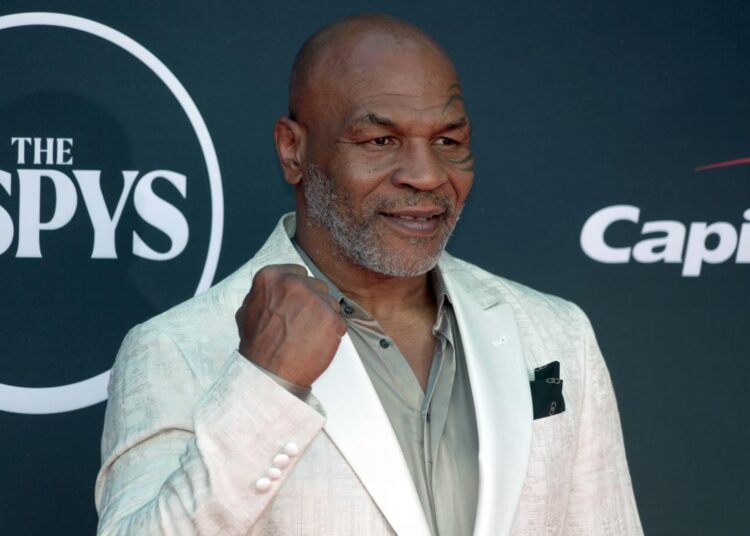When you’ve lived with tigers, tattooed your face and bitten off a piece of another man’s ear in the boxing ring, it’s hard to shock anyone.
But Mike Tyson generated buzz during a recent appearance on Logan Paul’s podcast when he said he consumes mushrooms of the psychedelic variety while he’s training for his fight against Jake Paul on Nov. 15.
“It takes me to heaven, baby,” Tyson said.
The former heavyweight champion is not alone when it comes to the use of “magic” mushrooms during high-performance training.
According to athletes and those familiar with the practice, a number of professional hockey players, professional golfers and MMA fighters are using psilocybin, which is the naturally occurring psychedelic drug also known as “magic mushrooms,” during training and in some cases during competition.
Heightened awareness and faster recovery are among reported benefits from “microdosing’’– taking a fraction of the regular dose of the drug and experiencing no psychoactive effect. (That does not appear to be the case with Tyson.)
“It makes you feel much more present,’’ said Ara Suppiah, a physician who has worked with Ryder Cup teams and estimated 4% to 5% of pro golfers are microdosing mushrooms. He declined to name the golfers but said they were not any he works with.
Pro golfer D.J. Trahan, who won PGA Tour events in 2006 and 2008, said the use of psychedelics starting in 2019 profoundly improved his well-being. He said his golf career has struggled despite microdosing off and on since 2021. But Trahan told USA TODAY Sports, “I know quite a few guys that are microdosing, and they have had tremendous success doing it, really. And I’m not at liberty to say anybody’s names, nor would I, because it’s not my place.”
Riley Cote, a retired NHL player, said he knows at least a dozen active NHL players microdosing mushrooms. He declined to name the players. Known as an enforcer, Cote has said he suffered concussions during on-ice fights and started using psilocybin after his NHL career ended in 2010 for physical and mental health issues.
“This is not even about just the hockey performance or sports performance, it’s just life performance,’’ said Cote, who played in 156 games for the Philadelphia Flyers between 2006 and 2010. “And I think it just extends to all of these different crafts because naturally high-end performers are always going to try and find an edge.’’
Rashad Evans, a former UFC light heavyweight champion who fought last in 2022, said he knows at least 30 UFC fighters who microdose regularly. He said he used mushrooms while training for his fight in 2022 and the drugs reduced soreness after sparring.
“The next day I feel totally rebooted and ready to do it again,’’ said Evans, who at 42 beat 35-year-old Gabriel Checco by unanimous decision.
When did athletes start using mushrooms?
It was eight years ago when Suppiah first heard of microdosing mushrooms in the world of golf, the physician said.
That was the same time PGA Tour player Morgan Hoffman disappeared into the Costa Rican jungle after being diagnosed with muscular dystrophy and emerged a vocal advocate of psychedelics. He rejoined the Tour in 2022.
Also, Suppiah said, podcasts such as “The Joe Rogan Experience” helped spread the word.
“They had guests on who started talking about microdosing,’’ Suppiah said. “Joe Rogan talked about microdosing. And those things are, podcasts, generally are very popular among golfers.’’
With a connection to Riley, Bramlage said he began working with hockey players six years ago.
Ian McCall, a retired MMA fighter, said he began working with other fighters five years ago. “But I didn’t see it take off until two years ago,’’ he said. One of his clients is Mark Irwin, a 36-year-old bareknuckle brawler from Southern California who said he took 7.5 grams of mushrooms the night he won the BYB Extreme lightweight title in 2023 – and was on mushrooms again when he lost the title later in the year.
Ultrarunner Michael Versteeg has talked about using mushrooms in training and in competition.
But it was Tyson whose open use of the drug raised its profile in the world of athletics. He credited psychedelics for turning around his life and said he used mushrooms while training for his exhibition fight with Roy Jones Jr. in 2020.
Adam Bramlage, who specializes in microdosing and said he works with a dozen NHL players and two snowboarders, said the average dosage for microdosing is 100 to 150 milligrams. He said it’s ingested an hour or two before training or performance and lasts four to six hours.
A two-month supply costs $100 to $200, according to Bramlage.
“Whether it’s Mike Tyson or it’s my NHL athletes, they get into a flow state where they’re no longer thinking about what they have to do later or what they did yesterday or the stressors of their life,” he said. “They’re just in the present moment.”
What are the risks?
Psychedelic mushrooms are not approved for use by the Food and Drug Administration (FDA) and, classified as a Schedule I substance under the Controlled Substances Act, they’re illegal under federal law.
In Oregon and Colorado, however, residents voted to make the supervised use of psilocybin legal. There’s a push to legalize the drug elsewhere, with one of several studies showing benefits such as treating addiction, depression and end-of-life mood disorders.
There’s no risk of a positive drug test for those athletes because it is not on the World Anti-Doping Agency list of prohibited substances. But Suppiah said he thinks that could change..
“The only question I have is are they going to look at it and say, is this an unfair advantage?’’ he said. “Is this performance enhancing and is it Adderall where you need a (Therapeutic Use Exemption) to say, ‘I have an attention deficit disorder, therefore I’m allowed to take this medication?’ ’’
WADA’s Prohibited List, according to communications manager Andrew Maggio, may include any substance or method that satisfies two of the following three criteria:
-
It has the potential to enhance or enhances sport performance.
-
It represents an actual or potential health risk to the athlete.
-
It violates the spirit of sport (this term is defined in the World Anti-Doping Code).
Based on current knowledge, Maggio said, psychedelics, including psilocybin, do not fulfill two of the three criteria to be considered for inclusion on the list.
The use of mushrooms does have potential health risks, according to the National Institute on Drug Abuse, which lists the following health risks: increased heart rate and blood pressure; nausea and vomiting; extreme fear, panic and paranoia; and flashbacks.
How mushrooms have impacted Tyson
There is no evidence mushrooms are a performance-enhancing drug, said Matt Johnson, a senior researcher for the Center of Excellence for Psilocybin Research and Treatment at Sheppard Pratt’s Institute for Advanced Diagnostics and Therapeutics in Maryland. Previously at John Hopkins, Johnson’s clinical trials have explored the effects of psychedelics on mystical experience, personality change, cancer distress treatment and depression treatment, according to his bio at Sheppard Pratt’s Institute.
But Johnson said he is open to the possibility based on Tyson reporting benefits. “I don’t dismiss it out of hand,’’ Johnson said. “If Mike Tyson says something enhances his performance, I’d weigh that. Again, not as proof, but I’d weigh that with serious consideration.
“I think the guy knows something about what affects his performance most likely. It doesn’t mean that he’s not susceptible to a placebo effect, but again, pretty open and it’s plausible. So yeah, I am curious about the whole situation for sure.’’
A publicist for Tyson, 58, did not respond to a request for comment submitted by USA TODAY Sports by email and text message.
Tyson’s recent appearance on the Logan Paul show was not the first time he’s discussed using mushrooms. Three years earlier, also on Paul’s podcast, he shoved a fistful of dry mushrooms in his mouth. Johnson, the researcher, noted that most people would not be able to train on high doses of mushrooms.
Tyson has credited the drug with helping him lose 100 pounds, give up cocaine and alcohol and improve his relationships with his wife and children. And for his return to boxing.
Last month, Tyson launched an at-home mushroom grow kit as part of a business collaboration featuring TYSON 2.0, the boxer’s cannabis brand.
But, in an interview that took place after Tyson experienced what his representatives described as an ulcer flareup that forced the fight to be postponed, he indicated he would have to speak to his doctor before using mushrooms. Based on his comments on Paul’s podcast, he appeared to have gotten approval.
“And he’s not saying, ‘I’m punching harder,’ ” said James Fadiman, a researcher of psychedelics and author of The Psychedelic Explorer’s Guide: Safe, Therapeutic, and Sacred Journeys. “But he is saying, ‘I can get in touch with that particular part of myself more easily.’ “
Actually, when Logan Paul asked Tyson why he uses mushrooms during his workouts, this is exactly what he said:
“Because I feel beautiful.”
Follow Josh Peter on social media @joshlpeter11
This article originally appeared on USA TODAY: Mike Tyson says he uses psychedelics while training. He’s not alone.
Read the full article here


























